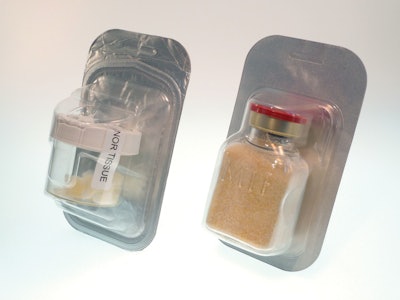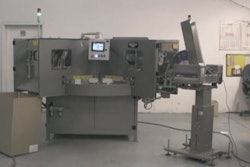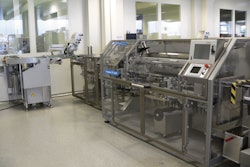Since its inception, the Edison, NJ-based Musculoskeletal Transplant Foundation (MTF) has made a positive difference in the lives of the recipients of the foundation’s donated human tissue forms that are implanted during orthopedic and spinal surgeries. Over 4.6 million tissue forms have been distributed from more than 84,000 tissue donors. The non-profit service organization, established in 1987 to meet a need for quality and consistent allograft supply, is a national consortium consisting of academic medical institutions, organ procurement organizations, and tissue recovery organizations. Demand for tissue for transplantation has been increasing annually and new novel tissue shapes have been developed to meet this demand. Maintaining the integrity of the tissues until the time of transplant is a critical need, so it’s understandable that MTF sought packaging to offer the type of protection the lyophilized tissue demands.
In 2008, MTF turned to Tanaka Kapec Design Group, Inc. to design the appropriate packaging (see sidebar story). Marc Jacobs, MTF’s vice president of product development, explains, “We’ve worked successfully with Tanaka Kapec for years, and I had worked with them before that with another company, so we were pleased with our experiences with them.”
“What we were trying to achieve was to contain as many cubic centimeters of tissue in the smallest overall package footprint that we could,” explains Alison Ling, MTF’s senior engineer. “We started with a cylinder shape, but the capacity was significantly less than we wanted, and so the rectangular shape we worked on with Tanaka was a key design feature.”
Tanaka’s Jeff Kapec, vice president and principal, provides the following details: “MTF packaged their tissue materials in both glass and a round injection-molded plastic container with a screw top. That container did not provide a complete sterile barrier due to the lyophilization processing, and it had a vent on top. Furthermore, the injection-molded plastic container, which fit inside the sterile barrier blister, did not have the capacity to contain the volume of allograft bone that MTF wished to have in each container. So separate from the issues they contended with in the glass container, the plastic container did not fully satisfy their packaging requirement either. Hence the intent to design a new package that would contain more tissue, but still fit inside the constraint volume dictated by the blister.”
Beyond shape, designing a new package involved finding a container material more suitable for safe transport, storage, and handling. Tanaka recommended cyclic olefin copolymers (COCs) and polymers (COPs), described by Wikipedia as “a relatively new class of [amorphous] polymers when compared to polypropylene and polyethylene [and used] primarily in applications requiring glass-like clarity including lenses, vials, monitors, and medical devices.” Ultimately, the company selected Zeonex®/Zeonor® COP engineering thermoplastics from Zeon Chemicals.
Tissue preparation to packaging
Even before accepting tissue for preparation, potential donors are carefully screened by MTF medical directors for medical and social histories, and any other relevant information. “Once approved,” says Ling, “we bring tissues into our clean rooms to be aseptically prepared and packaged. Each donor’s tissue has to be prepared separately under FDA and the American Assn. of Tissue Banks’ [AATB] guidelines, and MTF requirements. Tissue from each donor is cut into various sizes and shapes, depending on what kind of graft we are making. For grafts in this rectangular container, tissue is processed into chips, granules, or powders. After they have gone through the entire process, they are manually loaded into this bottle, in either 60-cc or 90-cc quantities.”
The 100-cc rectangular container is injection/blow-molded and sourced through Inoac. It measures 77-mm high x 52-mm wide x 45-mm deep, with rounded corners for safe, easy handling. With fewer companies making glass containers, MTFs decision to switch completely to plastic was made even easier.
Like glass, the new container also provides visual clarity, yet is also embossed with an MTF logo and with volumetric measurement gradations on the sides. Molded onto two sides are finger indents that allow hospital workers to better grasp the container for use in the sterile field.
Ling says the packaging maintains the sterility barrier to preserve the sensitive tissue and keep out moisture and any microorganisms. Once the tissue is placed into that rectangular bottle, it is manually topped with a rubber stopper from Stelmi and an aluminum crimp cap from West Pharmaceutical Services.
Afterward, packs are loaded into an outer one-compartment blister tray from Method Associates. Made of a PETG/Aclar® laminate from Honeywell, it further provides moisture barrier and handling protection. It is sealed with a foil lid from Oliver-Tolas Healthcare Packaging on a four-station sealer from Alloyd. Labels are applied to provide an expiration date, and serial unit number. Labels are printed and applied at MTF.
The primary filling process is performed in an ISO Class 4 clean room, and the blister packaging is performed in an ISO Class 5 clean room environment. These procedures will likely remain a manual process due to the small batch sizes associated with packaging donated allograft tissues. “Since we prepare and package tissue from only one donor at a time,” says Ling, “it’s a very small batch process.”
“In between preparation and packaging of each donor’s tissue the entire processing room is fully cleaned.”
Tissues in this package have up to a three-year shelf life. MTF ships tissue via FedEx to hospitals that store the packaged allograft on the shelf at ambient temperature until the time of implantation. When the tissue is used in surgery, hospital personnel take the rectangular container out of the blister, and then empty the tissue out of the container into a basin with a liquid solution in the sterile field to rehydrate the freeze-dried tissue. The surgeon uses as much of the tissue as necessary to repair a variety of musculoskeletal defects in the patient.
Ling says, “Hospitals and surgeons are excited that they are not receiving, handling, and discarding glass anymore.”


























